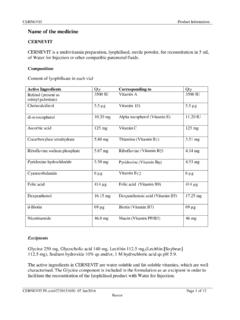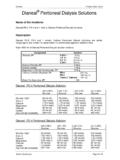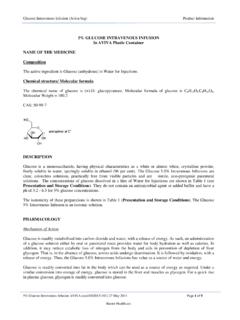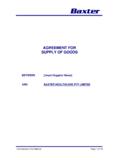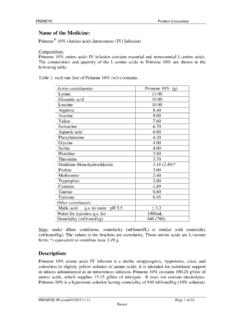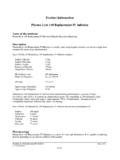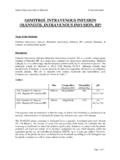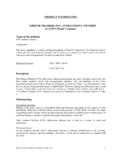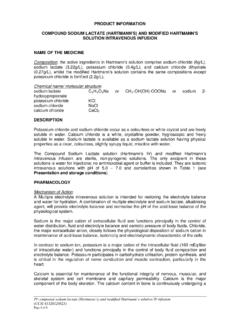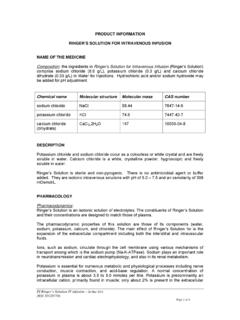Transcription of T I S S E E L [Fibrin Sealant] - Baxter Healthcare
1 tisseel ((frozen) fibrin sealant syringe) Product Information tisseel PI ccsi20820140919 Page 1 of 17 tisseel NAME OF THE MEDICINE tisseel [ fibrin sealant ] Two-Component fibrin sealant , Deep-Frozen, Vapour Heated (VH) and Solvent Detergent (S/D) treated, tisseel VH S/D1 DESCRIPTION The active ingredients of tisseel VH S/D are formulated as two sterile, deep-frozen solutions, the Sealer Protein Solution and Thrombin Solution (see Table 1 below for composit ion o f tisseel ). Each solution is presented in a separate preloaded chamber of one double-chamber syringe. The active ingredients are fractionated from pooled human plasma. Table 1: Composition of tisseel Sealer Protein so lution Thrombin Solution Active Ingredients -Aprotinin (synthetic) -Factor XIII -Fibrinogen -Thrombin (human) -Calcium chloride (2 H2O) Excipients -Albumin (human) -Hist idine -Nicotinamide -Polysorbate 80 -Sodium citrate -Water for injections -Albumin (human) -Sodium chloride -Water for injections The two deep frozen solutions comprising tisseel must be defrosted prior to use.
2 After thawing and warming up to 37 C, the two solutions are mixed during application (see DOSAGE AND ADMINISTRATION section, heading Method of Application). Chemical structures The major component of the clottable protein (human origin) is fibrinogen. The fibrinogen molecule is a dimer composed of two symmetrical subunits linked by -S-S- bonds. It could be written in a simple formula as (A , B , )2 and has a molecular weight (MW) of about 340 000. The A -chain contains 610 amino acids (MW about 68 000), the B -chain 461 amino acids (MW about 57 000), and the -chain 411 amino acids (MW about 47 000). Thus, the entire human fibrinogen contains 2964 amino acids. Thrombin (human origin) is a glycosylated protein, consisting of two polypeptide subunits A and B, covalently linked by one -S-S- bond. The molecular weight is about 33 800. The human thrombin subunit A chain is made of 36 amino acids, whilst the B chain contains 259 amino acids.
3 Factor XIII (human origin), also called blood-coagulation factor XIII, is a tetramer composed of two a-chains and two b-chains (each of a molecular weight of about 80 000) which are non-covalently associated. 1 The term Vapour Heated (VH) and Solvent Detergent (S/D) treated is abbreviated as VH S/D tisseel ((frozen) fibrin sealant syringe) Product Information tisseel PI ccsi20820140919 Page 2 of 17 Aprotinin (synthetic origin) is a protease inhibitor, a polypeptide consisting of one chain of 58 amino acids with a molecular weight of , also stabilized by -S-S- bonds. PHARMACOLOGY Pharmacodynamics tisseel contains two components, Sealer Protein Solution and Thrombin Solution. The Sealer Protein Solution contains fibrinogen as the main active ingredient, the active ingredient of the Thrombin Solution is human Thrombin. Thrombin is a highly specific protease that transforms the fibrinogen contained into fibrin monomers.
4 These fibrin monomers are then polymerized in a linear fashion and stabilised by cross-linking (catalysed by factor XIII) to form an insoluble fibrin clot. Aprotinin (synthetic) is a protease inhibitor which prevents the premature degradation of fibrin . These reactions simulate the key features of the physiological coagulation process. The resulting fibrin clot appears as a white, elastic mass which firmly adheres to tissue and which can be used to achieve haemostasis or seal tissues. When the two component solutions come into contact, conversion of fibrinogen to fibrin , and polymerization and cross-linking of fibrin monomers commences immediately and results in the clotting of the fibrin within seconds. The following diagram illustrates the process. Pharmacokinetics Solidified tisseel VH S/D is intended for local application only, therefore systemic exposure or distribution to other organs or tissues is not expected and pharmacokinetic studies were not conducted.
5 CLINICAL TRIALS tisseel VH S/D was evaluated in a prospective, parallel design, randomised (1:1), double-blind, multicenter clinical study against an earlier formulation of the product, tisseel VH2, in 317 subjects undergoing cardiac surgery requiring cardiopulmonary bypass (CPB) and median sternotomy. Patients were treated with tisseel VH S/D or the control product 2 Baxter commercialized several single virus inactivated, predecessor fibrin sealant products, utilizing heat treatment (HT) or vapor heat treatment (VH) for virus inactivation. Predecessor products were manufactured both in frozen or lyophilized presentation. Sealer Protein Solution (Fibrinogen and Factor XIII with Aprotinin 3000 KIU/mL) Thrombin Solution 500 (500 IU Thrombin/mL with calcium chloride 40 mol/mL) Sealer Protein- Thrombin Solution Solidified fibrin sealant tisseel ((frozen) fibrin sealant syringe) Product Information tisseel PI ccsi20820140919 Page 3 of 17 tisseel VH only when haemostasis was not achieved by conventional surgical methods.
6 For the end point, haemostasis achieved at the primary treatment site within 5 minutes of treatment and maintained until closure of the surgical wound, tisseel VH S/D was non-inferior to the earlier formulation of the product using a one-sided confidence interval on the difference in the proportion of subjects successfully treated. Haemostasis within 5 minutes and maintained until surgical closure tisseel VH S/D tisseel VH Intent to Treat Analysis 127/144 ( ) 129/144 ( ) Per Protocol Analysis 108/123 ( ) 122/135 ( %) Virus Safety To confirm virus safety of tisseel VH S/D, subjects were followed up for seroconversion due to virus infections. There were zero confirmed seroconversions for both tisseel VH S/D-treated subjects and tisseel VH-treated subjects: analysis of B19V seroconversion 1 month after surgery revealed a 0% (0/140) incidence of seroconversion in tisseel VH S/D-treated subjects and a 0% (0/138) incidence of seroconversion in tisseel VH-treated subjects.
7 Analysis of HAV, HBV, HCV, and HIV-1/-2 six months after surgery revealed a 0% (0/128) incidence of seroconversion in tisseel VH S/D-treated subjects and a 0% (0/134) incidence of seroconversion in tisseel VH-treated subjects. An earlier formulation of tisseel VH S/D, tisseel HT ( fibrin sealant heat-treated) was evaluated in an open-label crossover study against control topical haemostatic agents in 489 patients undergoing cardiovascular re-operation or re-sternotomy at 11 institutions. Patients were randomised to tisseel HT or control haemostatic agents when a topical haemostatic was needed at the conclusion of surgery and after all attempts of surgical haemostasis. Patients were crossed to the alternative therapy if bleeding continued after the 5 minute endpoint. At 10 centres, tisseel was used after administration of protamine sulfate. At one site, tisseel could be used before administration of protamine sulfate.
8 365 of the 489 patients had an eligible bleeding event, for the primary endpoint, successful haemostasis at 5 minutes, tisseel was statist ically significant ly superior to control topical haemostatic agents: Haemostasis within 5 minutes tisseel HT Control Topical Haemostatic Agent 159/193 ( ) 76/172 ( ) Pearson x2, two sided; p < ; intent-to-treat analysis Similarly, absolute time to cessation of bleeding was statistically significantly shorter for tisseel than for control topical haemostatic agents (p< , Wilcoxon-Gehan test, two sided). In a single centre, open label trial, an earlier formulation of tisseel was compared to historical controls in patients undergoing laparotomy for blunt or penetrating traumatic injury to the spleen and/or liver. Use of tisseel resulted in the need for statistically significantly fewer splenectomies than control haemostatic manoeuvres: tisseel ((frozen) fibrin sealant syringe) Product Information tisseel PI ccsi20820140919 Page 4 of 17 Splenectomy Rate Injury to: tisseel Historic Controls Spleen p < 0/19 14/22 Spleen and liver p < 1/26 19/34 tisseel did not result in statistically significantly reduced mortality in patients with blunt or penetrating trauma to the liver alone or to the liver and spleen (p = , 2, one sided).
9 In a single centre, prospective open label study of 120 patients randomised to standard of care (59 patients) or standard of care plus fibrin sealant (61 patients) for elective colostomy closure after temporary colostomy placement for treatment of traumatic injury to the colon, the earlier version of tisseel plus standard of care was shown to be statistically significantly superior to standard of care alone (p = , Jonckheere-Terpstra test for ordinal data, two sided) with regard to anastomotic complications (leakage, intra-abdominal abscess formation, re-operation, septic shock, and death). A review of published literature was conducted studying the repair of defects of the articular cartilage in the knee; (n= 293 patients; 166 patients were treated with either Autologous Chondrocyte Implantation (ACI) or Matrix-Induced Autologous Chondrocyte Implantation (MACI); 127 patients were treated with either mosaicplasty or microfracture or abrasive arthroplasty).
10 In all ACI/MACI procedures, tisseel fibrin sealant was applied topically. The efficacy of tisseel has been assessed indirectly by the efficacy outcome measures used to assess joint function following repair of cartilage defects. Outcome measures within the first six months of treatment are considered to be of particular importance because treatment failure attributed to graft movement ( , periosteal delamination or detachment of the collagen matrix) typically occurs within the first three to six months following implant. In addition, in the first 6 months post-implant, there were no reports by patients of symptoms which may be indicative of graft instability such as locking or catching of the knee joint. In one study MRI assessments, made at one and two months, showed that there was a high level of graft integration with the surrounding cartilage, and that grafts were present and in their original posit ion in the majority of patients (15/17).
